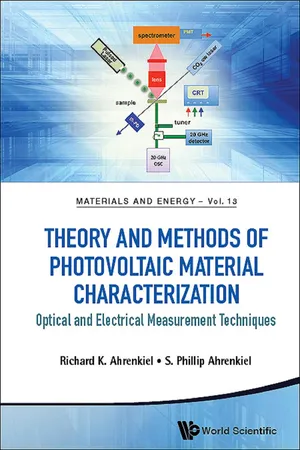
Theory and Methods of Photovoltaic Material Characterization
Optical and Electrical Measurement Techniques
- 328 pages
- English
- ePUB (mobile friendly)
- Available on iOS & Android
Theory and Methods of Photovoltaic Material Characterization
Optical and Electrical Measurement Techniques
About This Book
This book provides an extensive review of the theory of transport and recombination properties in semiconductors. The emphasis is placed on electrical and optical techniques. There is a presentation of the latest experimental and theoretical techniques used to analyze minority-carrier lifetime. The relevant hardware and instrumentation are described. The newest techniques of lifetime mapping are presented. The issues are discussed relating to effects that mask carrier lifetime in certain device structures. The discrepancy between photoconductive and photoluminescence measurement results are analyzed.
Contents:
- Semiconductor Fundamentals and Background
- Optical Absorption and Radiative Recombination
- Mobility and Defect Recombination
- Carrier Diffusion and Confinement — Transient and Steady State Theory
- Carrier Dynamics in Planar Device Structures
- Transient Photoconductivity
- Time-Resolved Photoluminescence: Techniques and Analysis
- Auger Recombinationn
- Trapping Spectroscopy
- Steady State Techniques
- Free Carrier Absorption
- Recombination in Charge Separation Structures
- Photon Recycling
- Simultaneous and Comparative Measurements
- Summary and Future Work
Readership: Science students and professionals in the field of physical chemistry and semiconductors, especially femtochemistry and those with interest in science. Photovoltaics;Optical and Electrical Measurement Techniques;Semiconductors;Carrier Transport;Recombination Lifetime;Carrier Lifetime;Minority Carrier Lifetime0 Key Features:
- The topic is central and critical to photovoltaic device testing. Many researchers approach lifetime as a parameter that can be inferred indirectly from device performance or standard steady-state or transient measurements. This book updates the tools for comprehensive analysis of recombination phenomena and the influences of electrical injection levels, impurity-concentrations and spectra, surfaces and interfaces, and intrinsic materials properties
Frequently asked questions
Information
CHAPTER 1
Semiconductor Fundamentals and Background
1.1.Tetrahedral Semiconductors






Table of contents
- Cover
- Halftitle
- Series Editors
- Title
- Copyright
- Contents
- Dedication
- Preface
- Acknowledgements
- 1. Semiconductor Fundamentals and Background
- 2. Optical Absorption and Radiative Recombination
- 3. Mobility and Defect Recombination
- 4. Carrier Diffusion and Confinement — Transient and Steady State Theory
- 5. Carrier Dynamics in Planar Device Structures
- 6. Transient Photoconductivity
- 7. Time-Resolved Photoluminescence: Techniques and Analysis
- 8. Auger Recombination
- 9. Trapping Spectroscopy
- 10. Steady State Techniques
- 11. Free Carrier Absorption
- 12. Recombination in Charge Separation Structures
- 13. Photon Recycling
- 14. Simultaneous and Comparative Measurements
- 15. Summary and Future Work
- Index